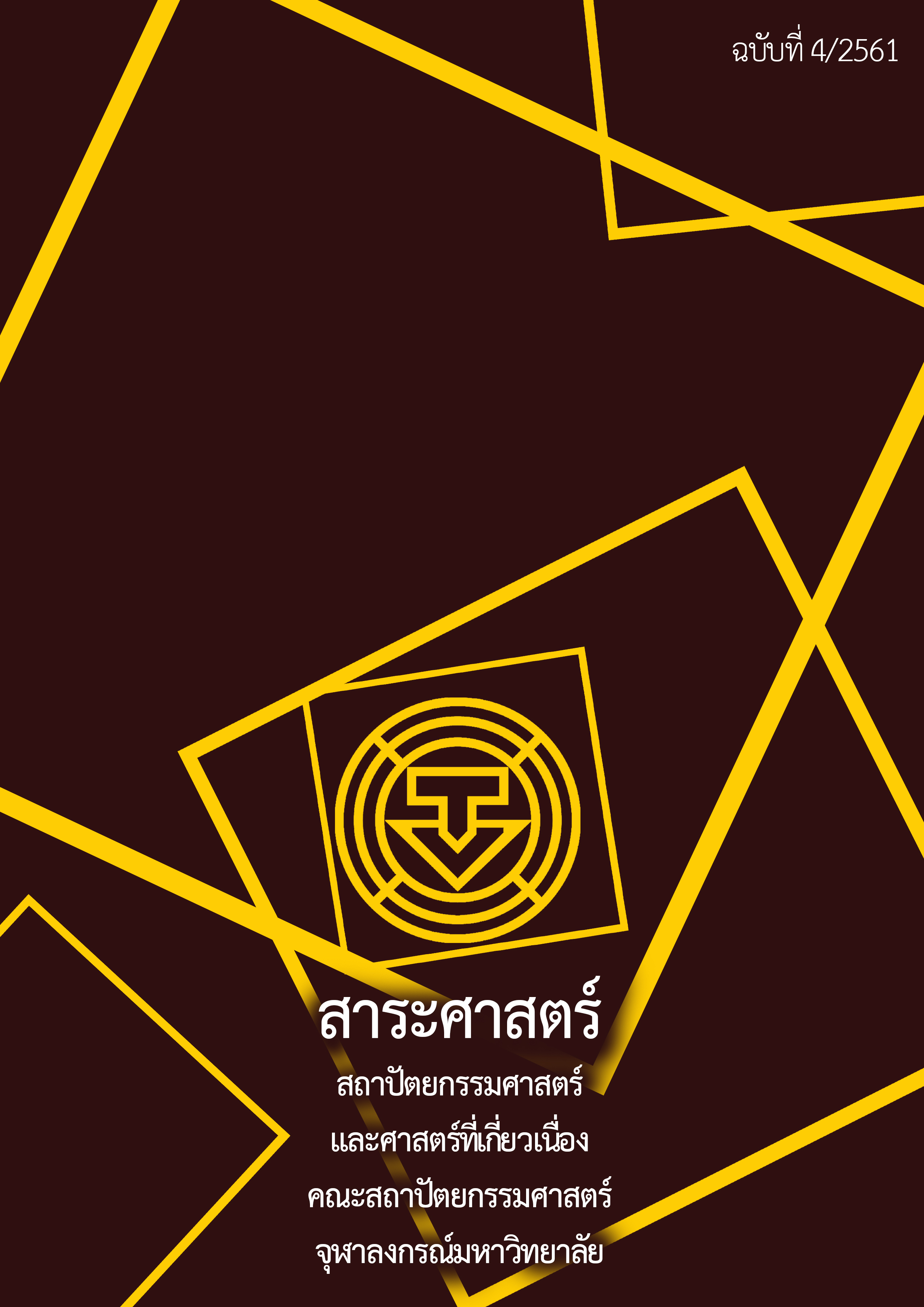Pattern of Pool Villas Operated by Small Enterpreneurs in Hua Hin District, Prachuap Khiri Khan Province
Main Article Content
Abstract
Tourists’ behaviors that tend to change into Special Interest Tourism (SIT) have led to the growth of pool villa business. The objective of this research is to study physical features and components of pool villas located within the Hua Hin area and managed by small and medium Enterprises (SMEs). Data to be studied is collected from tourism websites, tour agency interviews as well as on-site exploration of targeted villas. The data analysis is conducted by indicating each villa’s location in the map, creating plans and comparing development details, physical features and components of each accommodation.
The results show that, firstly, pool villa operators have ideas to transform their residences into a place that can earn them money by providing a swimming pool or other additional facilities. This also includes development of personnel management system in order to increase potential through alignment with requirements of the tourists. Secondly, the locations of pool villas are categorized into 2 types, which are 1) villas set adjacent to the beach, or 50-200 meters from the beach; 2) villas located in the city area, 10-30 km from Hua Hin Municipality Office, of which the number is higher than that of the former mentioned (80%). Thirdly, pool villas can be categorized into 3 types based on the housing project prior to their transformation into accommodation for tourists i.e. residences located outside housing projects, residences located in housing projects, and pool villas in housing projects that are initially constructed for tourism purposes. The most found is the type which the pool villas are transformed from the residences located outside housing projects (70%). Fourthly, rates of pool villas are varied depending on the location of the accommodation. It is also found that stays on weekdays enjoy lower rates with average rates of only THB 460-790 per guest, and the rates are adjustable at all time.
According to the study, it indicates that the ideas of the operators in transforming their residences have different effects to physical features and components of pool villas and also reflect development patterns, which are in line with the changing travel behaviors. This study is beneficial to villa operators in the Hua Hin area and those in other areas that possess similar characteristics, which have influences on the tourism promotion of the government and the private sectors in responding to the needs of tourists in the future.
Article Details
References
กระทรวงการท่องเที่ยวและกีฬา. กรมการท่องเที่ยว. แผนพัฒนาการท่องเที่ยวแห่งชาติ ฉบับที่ 2 (พ.ศ.2560-2564). กรุงเทพฯ: การท่องเที่ยวแห่งประเทศไทย, 2558.
กฤษณะ พัชรภิญโญ. “ปัจจัยการเลือกห้องพักอาศัยของนักท่องเที่ยวในโรงแรมระดับ 3 ดาว กรณีศึกษา โรงแรมริเวอร์ไซด์ กรุงเทพมหานคร. ” วิทยานิพนธ์ปริญญามหาบัณฑิต ภาควิชาเคหการ คณะสถาปัตยกรรมศาสตร์ จุฬาลงกรณ์มหาวิทยาลัย, 2549.
การท่องเที่ยวแห่งประเทศไทย. กองสถิติและวิจัยการท่องเที่ยวแห่งประเทศไทย. “สถิติการท่องเที่ยวภายในประเทศ
ปี 2558.” สืบค้น 10 ธันวาคม 2560. https://www.mots.go.th/more_news.php?cid=411.
ณัฏฐิกา รักเสนาะ. “ปัจจัยที่มีความสัมพันธ์กับการเลือกใช้บริการบูติคโฮเต็ลของนักท่องเที่ยวชาวไทย ในอำเภอ
หัวหิน จังหวัดประจวบคีรีขันธ์.” การค้นคว้าอิสระปริญญามหาบัณฑิต สาขาวิชาการประกอบการ คณะการ
จัดการการท่องเที่ยว มหาวิทยาลัยศิลปากร, 2553.
ถิรวุฒิ ธนวิชเพียรพาก. “แนวทางการปรับตัวของโรงแรมท้องถิ่นระดับราคาประหยัด กรณีศึกษาพื้นที่เขตกรุงเทพมหานครและเมืองพัทยา.” วิทยานิพนธ์ปริญญามหาบัณฑิต ภาควิชาเคหการ คณะสถาปัตยกรรมศาสตร์ จุฬาลงกรณ์มหาวิทยาลัย, 2552.
Tourism Authority of Thailand. “สถานการณ์การท่องเที่ยว หัวหิน จ.ประจวบคีรีขันธ์.” สืบค้น 10 ธันวาคม 2560.
https://www.tourism.go.th/view/1/%E0%B8%AA%E0%B8%96%E0%B8%B4%E0%B8%95%E0%B8%B4%E0%B8%99%E0%B8%B1%E0%B8%81%E0%B8%97%E0%B9%88%E0%B8%AD%E0%B8%87%E0%B9%80%E0%B8%97%E0%B8%B5%E0%B9%88%E0%B8%A2%E0%B8%A7%E0%B8%A0%E0%B8%B2%E0%B8%A2%E0%B9%83%E0%B8%99%E0%B8%9B%E0%B8%A3%E0%B8%B0%E0%B9%80%E0%B8%97%E0%B8%A8%20%E0%B8%9B%E0%B8%B5%202558/TH-TH.
เบญนภา จันทร์กลับ. “แนวโน้มการพัฒนารูปแบบโรงแรมบูติก: กรณีศึกษาโรงแรมในเขตอำเภอหัวหิน-ชะอำ.”
วิทยานิพนธ์ปริญญามหาบัณฑิต ภาควิชาเคหการ คณะสถาปัตยกรรมศาสตร์ จุฬาลงกรณ์มหาวิทยาลัย, 2554.
วราลี เวชชธรรม. “การขออนุญาตอาคารประเภทโรงแรมภายใต้กฎหมายไทย กรณีอาคารที่มีขนาดต่ำกว่าอาคารขนาดใหญ่ ตามกฎหมายควบคุมอาคาร.” วิทยานิพนธ์ปริญญามหาบัณฑิต ภาควิชาสถาปัตยกรรมศาสตร์ คณะสถาปัตยกรรมศาสตร์ จุฬาลงกรณ์มหาวิทยาลัย, 2555.
“สำนักงานส่งเสริมวิสาหกิจขนาดกลางและขนาดย่อม (สสว.).” สืบค้น 10 ธันวาคม 2560.
https://www.rd.go.th/publish/38056.0.html.
Gray, William S. Hotel and Motel Management. 3rd ed. Englewood Cliffs, NJ.: Prentice Hall, 1994.
Kotler, Philip. Marketing for Hospitality and Tourism. 3rd ed. Upper Saddle River, NJ.: Pretice Hall, 2003.
Kotler, P. and Kevin Lane Keller. Marketing Management. 15th ed. Boston: Pearson, 2016.
Morgan, M. Marketing for Leisure and Tourism. London: Prentice Hall, 1996.
Seubsamarn, Kanoknon. “Tourist Motivation to Use Homestays in Thailand and their Satisfaction
Base on the Destination’s Cultural.” Master of Science, University of Missouri, 2009.
Barth, S.C. Hospitality Law: Managing Legal Issues in the Hospitality Industry. 3rd ed. Hoboken, NJ. :
John Wiley & Sons, 2009.


